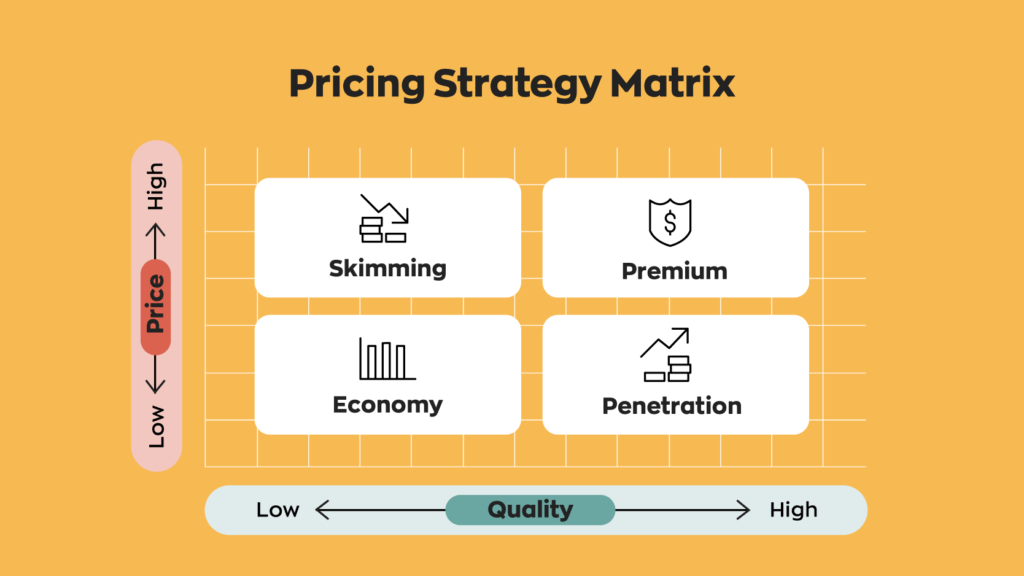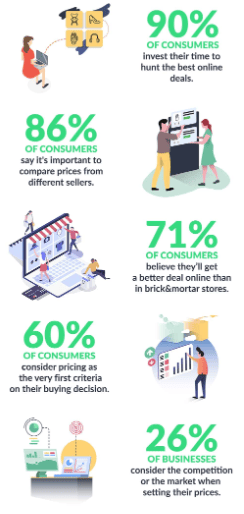Are you feeling like a lost sailor in a sea of pricing strategies? Don’t worry, we’ve got your back! In this pricing guide, we will be your compass, guiding you through the treacherous waters of pricing.
Get ready to embark on a journey to boost your profit and leave your competition in the dust. Pricing can make or break your business, so it’s crucial to navigate these strategies with confidence.

From competition-based pricing to value-based pricing, we will explore a variety of techniques to help you stay ahead of the game.
So, tighten your grip on the helm and get ready to master pricing strategies like a seasoned captain!
Key Takeaways
- Pricing strategies are essential for maximizing profit and beating competition.
- Value-based pricing is a effective approach that captures maximum customer value and leads to increased customer loyalty and higher profit margins.
- Market research is crucial in making informed pricing decisions.
- Different types of pricing strategies, such as competition-based pricing, cost-plus pricing, and dynamic pricing, have their own benefits and limitations, and the best approach depends on the specific business and industry.
Importance of Pricing Strategies
To maximize profit and beat your competition, understanding the importance of pricing strategies is crucial for your business success.
Pricing strategies play a significant role in determining the value of your products or services in the market. One key strategy is value-based pricing, which focuses on setting prices based on the perceived value that your offerings bring to customers. By adopting this approach, you can capture the maximum amount of value that customers are willing to pay.

This strategy offers several benefits, including increased customer loyalty, higher profit margins, and improved market positioning.
However, to implement value-based pricing effectively, market research plays a vital role. Market research helps you understand customer preferences, price sensitivity, and competitive landscape, allowing you to make informed pricing decisions that align with your business goals.
Common Types of Pricing Strategies
To understand common types of pricing strategies, you need to explore various approaches that can help you boost profits and beat your competition.
There are several pricing strategy examples that can benefit your business. One such strategy is competition-based pricing, where you use your competitors’ prices as a benchmark. This allows you to stay competitive and dynamic in the market.
Another strategy is cost-plus pricing, which focuses on the cost of producing the product or service. By adding a fixed percentage to the production cost, you can ensure a desired profit.
It’s important to note that each strategy has its own benefits and limitations, and the best approach depends on your specific business and industry.
Competition-Based Pricing
Continuing from the previous subtopic, let’s explore the benefits of competition-based pricing and how it can help you stay competitive in the market.
Competition-based pricing is a strategic approach that involves using competitors’ prices as a benchmark for your own pricing decisions. By conducting thorough competition analysis and pricing benchmarking, you can identify the optimal price point that allows you to position yourself favorably against your competitors.
This pricing strategy enables you to respond dynamically to market conditions and customer expectations. It’s particularly effective in highly saturated spaces where price plays a significant role in customers’ decision-making processes.
Cost-Plus Pricing
For cost-plus pricing, you should consider using an article determiner. Cost-plus pricing is a pricing strategy that focuses on the cost of producing a product or service. It involves adding a fixed percentage to the production cost to determine the selling price. This strategy is commonly used by retailers selling physical products.
One advantage of cost-plus pricing is that it ensures that all costs are covered and a desired profit margin is achieved. It’s also relatively easy to calculate and implement.
However, there are disadvantages to consider. Cost-plus pricing doesn’t take into account market demand or competitor prices, which can lead to pricing that isn’t competitive. Additionally, it may not be suitable for service-based or SaaS companies where the production cost isn’t easily quantifiable.
Dynamic Pricing
Dynamic pricing is a strategy that adjusts prices in real time based on various factors such as demand, market conditions, and customer behavior. In the e-commerce industry, dynamic pricing offers several benefits.
Firstly, it allows businesses to maximize revenue by setting prices that reflect the current market demand. This strategy also enables companies to stay competitive by responding quickly to changes in the market and adjusting prices accordingly.
Additionally, dynamic pricing can help businesses optimize inventory management by balancing supply and demand. However, implementing dynamic pricing in the retail industry comes with its challenges.
One of the main challenges is the need for accurate and real-time data to make informed pricing decisions. Another challenge is ensuring that dynamic pricing strategies align with the overall pricing strategy and brand image.
Despite these challenges, dynamic pricing can be a powerful tool for businesses to increase profitability and gain a competitive edge in the market.
High-Low Pricing
To effectively implement high-low pricing, a strategic approach is necessary. This approach should aim to maximize profitability while also enticing customers with attractive deals. High-low pricing involves offering products at higher prices during certain periods and then reducing those prices during promotions or sales events. This strategy creates pricing fluctuations that can appeal to customers’ desire for a good deal.
By using high prices as reference points, customers perceive the discounted prices as more favorable. This perception leads to increased sales as customers believe they are getting good value for their money. This pricing psychology takes advantage of customers’ perception of value and their willingness to pay.
However, it’s important to carefully plan and execute this strategy. If not done properly, it can devalue the product or alienate customers who may choose to wait for sales. Therefore, strategic implementation is crucial.
Penetration Pricing
Implement penetration pricing to gain a competitive edge and maximize profitability in your market. Penetration pricing is a pricing strategy wherein you set your initial prices lower than your competitors to quickly capture market share. This approach offers several advantages.
Firstly, it can attract price-sensitive customers who are more likely to switch brands for a lower price.
Secondly, it can deter potential competitors from entering the market, as it becomes difficult for them to match your low prices.
Successful examples of penetration pricing include companies like Netflix and Uber. They entered their respective markets with low prices, quickly gained a large customer base, and then gradually increased prices once they established themselves as market leaders.
Various Pricing Models Dilema
I know we mentioned a lot of pricing strategies in this pricing guide, choose the right pricing model to optimize your profit and outperform your competitors. When deciding on a pricing model, it’s important to consider various factors that influence pricing decisions.
Comparing different pricing models can help you determine which one aligns best with your business goals and target audience. Factors such as production costs, market demand, and customer-perceived value should be taken into account.
For example, a cost-plus pricing model focuses on the cost of production and adds a fixed percentage of profit. On the other hand, a value-based pricing model considers the perceived value of your product or service in the eyes of your customers.
Best Pricing Strategies for Profit and Competition
When competing for profit, it’s crucial to adopt effective pricing strategies.
To maximize your profit and beat the competition, you need to employ the best pricing tactics and optimize your pricing strategy.
One effective pricing tactic is competition-based pricing. By using your competitors’ prices as a benchmark, you can choose to price below, at the same level, or above them, depending on your market positioning. This strategy helps you stay competitive and dynamic in the market, especially in highly saturated spaces.
Another strategy to consider is cost-plus pricing, which focuses on the cost of producing your product or service. By adding a fixed percentage to the production cost, you can ensure a desired profit margin. However, keep in mind that this strategy is more suitable for retailers selling physical products rather than service-based or SaaS companies.
Conclusion to the Pricing Guide
By mastering the art of pricing strategies, you have unlocked the key to boosting your profits and leaving your competition in the dust.
Just like a skilled archer hitting the bullseye every time, you have learned to set prices that captivate your target audience and maximize your revenue.
So go forth, armed with the knowledge of pricing strategies, and conquer the market with your strategic prowess.
Success awaits you!







